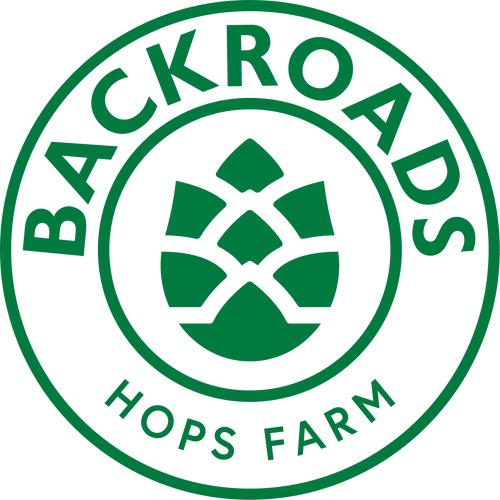For our first beer collaboration we decided to document a behind the scenes look at the London Brewing process that results in an incredible beer. We asked Aaron, co-owner and head brewer of London Brewing to talk the brewing process and what goes into making a great Golden Ale beer.
"It’s always been our position at London Brewing that you can’t make a truly local craft beer without using locally grown ingredients, and the Backroads Golden Ale certainly fits the bill. To get to the desired end beer in the glass, you have to start at the beginning. For the Backroads Golden Ale, the goal was a fairy crisp, clean character, easy to drink beer on the paler side of the beer colour spectrum with just enough malt backbone to keep things interesting. To that end to build the base, we started with a blend of local organic newdale malt and simple Canadian 2-row. The Newdale was grown by Dalton White Farms in Norfolk County, a fantastic 7th generation family farm. It was then micro-malted by Mike Driscoll of Harvest Hop and malt in Guelph, before being delivered very fresh to London Brewing. It provides the malt depth to the Golden Ale while the Canadian 2-Row gives a very pale colour and more neutral palette to layer the hops on. For hops, of course, we were using Backroads, in particular their Triple Pearl which gives a very clean bitterness to balance the malts used with a very light touch of bright citrus. Finally, we selected a very clean workhorse of an American ale yeast, to ferment everything without providing a lot of competing flavours in the glass.
Once the recipe is created, it’s on to the brewday where our job as brewers is to make food for yeast hijacking natural biological processes and using strangely named equipment. Step 1, preheat the mashtun (big insulated, steam jacketed tank with a wedgewire bottom) with hot liquor (hot water), then start your dough-in (mixing of milled malts with water through the grist hydrator at specific temperatures and flow rates) to achieve your desired mash temperature. Our goal here is to open up the grain to make the starch accessible, thoroughly wet everything and activate the enzymes in the grain to convert the complex starches into simpler sugars to feed the yeast. After about an hour, we’ll start the lautering process, slowly drawing the sugar and nutrient rich wort (malt sugar water) from the bottom of the mashtun and into the boil kettle (no explanation necessary). As we do that, we’re sprinkling more water on top, to try and bring over as many of the sugars as we can.
Boiling is where the hops come in to play for the Golden Ale. There’s a fairly substantial initial addition that lays down a bittering base to balance the sweetness of the final beer. There’s a smaller addition towards the end of the boil that layers in a bit more hop flavor and aroma. An hour layer, we’ll use a pump to create a whirlpool in the boil kettle, gathering all of the now spent hops and proteins into a nice tight pile in the middle of the kettle so we can draw nice clear hopped wort from the edges. We’ll pump this wort through the plate heat exchanger to bring the near boiling wort down to 19 degrees and on to the clean and sanitary conical fermenting vessel that will maintain that temperature throughout the fermentation process. Along the way, we’ll pitch (add) our yeast and some oxygen to keep the yeast healthy throughout the process. Then our job as brewers is mostly done apart from all the cleanup. We’ll monitor the progress of the yeast in converting the wort into beer, changing malt sugars into alcohol, c02 and a few other things along the way. When the yeast’s work is done, we’ll seal up the tank and slowly bring them temperature of the beer down to near freezing to encourage the yeast to flocculate (settle to the bottom) and clarify the beer. Then the beer is off to the brite tank, where it clarifies further and c02 is added to carbonate the beer."
- Aaron Lawrence, Co-owner & Head Brewer
























Packaging day
The goal of packaging is to get the right amount of beer into the can without exposing it to oxygen, which would promote staling. To that end, we use a rotary counter pressure can filler. It’s a noisy affair with lots of moving parts and when they’re all working well together it’s pretty mesmerizing to watch. If things go wrong you’ve got 34 cans a minute going in the wrong direction. Cans are agitated down the shaker table, past the date coder that records the lot number for traceability, flipped upside down and given a rinse, flipped right side up and into the first star wheel that feeds the rotary filler. As the cans rotate around the filler they are purged of oxygen with a blast of c02, then sealed and pressurized, and then filled. The filling valve creates a nice cascade of beer down the edges of the can with gentle laminar flow that minimizes foaming. Since the can is pressurized, there isn’t really any foaming to speak of as the can exits the rotary filler, so we use a bubble breaker to spray an extremely fine high pressure jet of deaerated water onto the top of the can to get it to foam up so the seaming station can drop the lid onto a nice cap of foam keeping any oxygen out of the can. Then the lid smacker does exactly that and the seamer head crimps and squeezes the lid onto the top of the can and sends it off to be rinsed and blown dry before being packed into a case. Finally, ready to drink!











